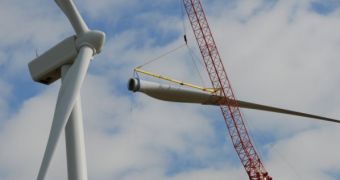Working together with the market-leading supplier of wind-power solutions, Vestas Wind Systems, QinetiQ has recently managed to demonstrate a new wind-turbine blade design that supposedly represents a unique radar mitigation technology for the developing industry. QinetiQ, a renowned technology provider and consultancy to the energy and environmental sectors, and Vestas were funded for this line of work by the Government Department for Business Innovation and Skills (BIS) of the United Kingdom, a press release on the corporation's website announces.
“We believe that Stealth Turbine technology could be a genuine game-changer for the renewable energy industry by removing a major barrier to its development,” QinetiQ's Strategic Business Director for Energy and Environment, Mark Roberts, says. The new design, which was recently showcased at a wind farm in Norfolk, England, features a 44-meter prototype turbine blade, which is capable of considerably reducing the radar signature of the turbine. With this innovation, the facilities could essentially be taken out of the equation in air traffic control and air defense systems.
“This is another great example of QinetiQ applying its expertise in defense technologies to a different sector. Our long-standing involvement in the development of stealth techniques for ships and aircraft has enabled us to quickly, seamlessly and cost-effectively transfer this expertise to the renewable energy market. We believe that the ability to leverage our scientific and technical heritage across industries will enable us to continue to develop innovative solutions for the energy sector,” Roberts adds of the company's achievements.
All three basic components that go into the turbine, namely the blades, nacelle and tower, feature radar-absorbing materials (RAM), the official note says. Additionally, these materials can be tuned in a way that synchronizes them with the radar frequencies used by the maritime and air forces. At the Swaffham Wind Park, in Norfolk, QinetiQ experts mounted the new blade atop a Vestas V90 turbine, and then took radar cross section (RCS) measurements, using a multiband pulsed radar (MPR) system. The analysis showed a significantly reduced RCS, when compared with other, traditional wind-turbine designs.

 14 DAY TRIAL //
14 DAY TRIAL //